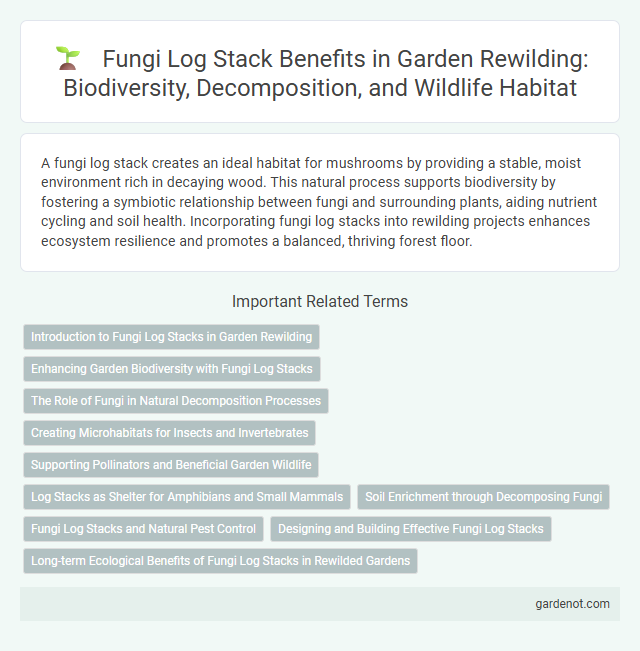A fungi log stack creates an ideal habitat for mushrooms by providing a stable, moist environment rich in decaying wood. This natural process supports biodiversity by fostering a symbiotic relationship between fungi and surrounding plants, aiding nutrient cycling and soil health. Incorporating fungi log stacks into rewilding projects enhances ecosystem resilience and promotes a balanced, thriving forest floor.
Introduction to Fungi Log Stacks in Garden Rewilding
Fungi log stacks play a crucial role in garden rewilding by creating habitats that support biodiversity and enhance soil health through natural decomposition processes. These stacks, consisting of logs inoculated with fungal spores, promote mycelium growth that breaks down organic matter, enriching the ecosystem with essential nutrients. Incorporating fungi log stacks encourages symbiotic relationships between fungi, plants, and microorganisms, fostering a resilient and self-sustaining environment.
Enhancing Garden Biodiversity with Fungi Log Stacks
Fungi log stacks create a microhabitat that supports diverse soil microorganisms, insects, and small wildlife, significantly enhancing garden biodiversity. By decomposing woody material, these fungi release essential nutrients that improve soil health and promote robust plant growth. Incorporating fungi log stacks fosters a self-sustaining ecosystem, increasing resilience and ecological balance within garden environments.
The Role of Fungi in Natural Decomposition Processes
Fungi play a critical role in natural decomposition by breaking down complex organic matter, such as dead wood, into nutrients that enrich soil ecosystems. Their enzymatic activity accelerates the recycling of carbon, nitrogen, and other essential elements, supporting plant growth and biodiversity within rewilded habitats. By fostering fungal colonization in log stacks, rewilding projects enhance habitat complexity and promote sustainable ecosystem functioning.
Creating Microhabitats for Insects and Invertebrates
Fungi log stacks serve as essential microhabitats that support diverse insect and invertebrate populations by providing moisture, shelter, and food resources. These decomposing wood structures foster fungal growth which attracts detritivores and saproxylic species crucial for nutrient cycling and ecosystem health. Enhancing biodiversity through fungi log stacks promotes natural pest control and boosts soil fertility in rewilding projects.
Supporting Pollinators and Beneficial Garden Wildlife
A fungi log stack creates a habitat rich in mycelium that supports pollinators such as bees and butterflies by providing shelter and foraging opportunities. The decomposition process enriches soil nutrients, attracting beneficial insects like ladybugs and predatory beetles that control pests naturally. Integrating fungi log stacks into gardens promotes biodiversity and enhances ecosystem resilience important for successful rewilding projects.
Log Stacks as Shelter for Amphibians and Small Mammals
Log stacks provide essential microhabitats that support biodiversity by offering shelter and moisture retention for amphibians such as salamanders and frogs, as well as small mammals like shrews and voles. The decaying wood in log stacks fosters fungal growth, which contributes to nutrient cycling and enhances the structural complexity needed for these species to thrive. Creating log stacks in rewilding projects promotes resilient ecosystems by sustaining habitat connectivity and protecting vulnerable fauna from predators and environmental extremes.
Soil Enrichment through Decomposing Fungi
Fungi log stacks accelerate soil enrichment by decomposing organic matter and releasing essential nutrients such as nitrogen, phosphorus, and potassium back into the soil. This decomposition process enhances soil structure, increases microbial diversity, and promotes nutrient cycling critical for plant growth in rewilding projects. The presence of diverse fungal species in log stacks also supports symbiotic relationships with plants, improving soil health and ecosystem resilience.
Fungi Log Stacks and Natural Pest Control
Fungi log stacks create microhabitats that support diverse fungal species essential for natural pest control by breaking down organic matter and releasing bioactive compounds that deter harmful insects. These decomposing logs foster beneficial fungi such as mycorrhizal and entomopathogenic species, which suppress pest populations while enhancing soil health. Integrating fungi log stacks into rewilding projects promotes ecological balance by reducing reliance on chemical pesticides and encouraging biodiversity.
Designing and Building Effective Fungi Log Stacks
Designing and building effective fungi log stacks involves selecting hardwood logs, such as oak or maple, which provide optimal substrates for mycelium growth. Logs should be freshly cut and stacked in a shaded, moist environment to maintain the necessary humidity for fungal colonization. Proper orientation and spacing between logs ensure air circulation, reducing contamination risk and promoting healthy fungal development.
Long-term Ecological Benefits of Fungi Log Stacks in Rewilded Gardens
Fungi log stacks in rewilded gardens enhance soil health by decomposing organic matter and recycling nutrients, fostering biodiversity through habitat creation for various microorganisms and invertebrates. These fungal ecosystems improve moisture retention and carbon sequestration, contributing to climate resilience over time. Their long-term presence supports a balanced and self-sustaining garden ecosystem, promoting flora and fauna diversity essential for ecological restoration.
Fungi log stack Infographic

 gardenot.com
gardenot.com